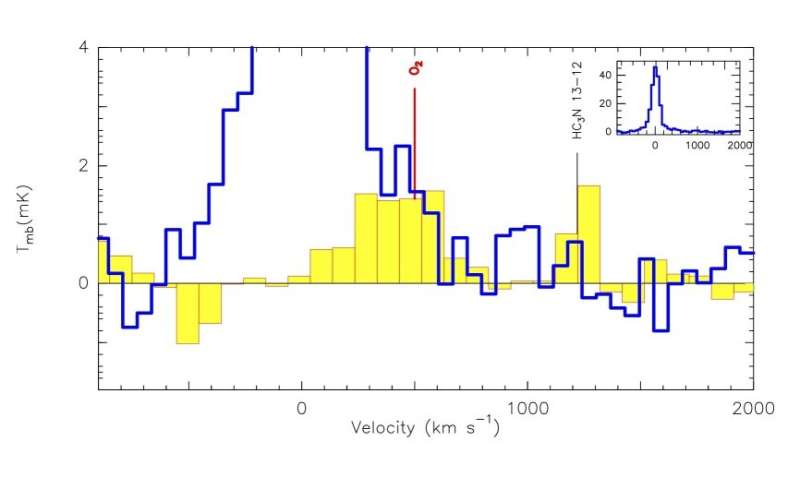Molecular oxygen emission in Mrk 231 observed with the IRAM 30 meter telescope. Credit: Wang et al., 2020.
Observations using the IRAM 30 meter telescope and the NOEMA Interferometer have unveiled the presence of molecular oxygen in Markarian 231—the nearest known quasar. The finding, detailed in a paper published on the arXiv preprint server, could be crucial for better understanding the properties of molecular gas in this object.
Powered by supermassive black holes (SMBHs), quasars, or quasi-stellar objects (QSOs) are extremely luminous active galactic nuclei (AGN) with luminosities up to thousands of times greater than that of the Milky Way galaxy. Most quasars are known to eject huge amounts of material into their host galaxies. Hence, detecting and observing such outflows could provide important hints about the evolution of galaxies.
Studies of oxygen and its chemistry in interstellar clouds are crucial to advance our knowledge about molecular gas, as it is the third-most abundant element in the universe. However, such studies are challenging, as, due to the attenuation of Earth's atmosphere, it is impossible to observe lines of molecular hydrogen (O2) of galactic objects near their rest frequencies from the ground. The problem disappears when studying O2 lines in extragalactic sources, as they are red-shifted away from the attenuation of the Earth's atmosphere, and therefore can be observed with ground-based instruments.
Located some 581 million light years away, Markarian 231 (or Mrk 231 for short) is the nearest known QSO and the most luminous ULIRG (Ultra-Luminous InfraRed Galaxy) in the local universe. The quasar showcases high velocity molecular outflows, as well as millimeter emission of carbon monoxide (CO), and is observed in dense gas tracers. All in all, the properties of Mrk 231 make it an excellent target to search for extragalactic O2 emission.
Astronomers led by Junzhi Wang of the Shanghai Astronomical Observatory in China, has performed deep observations toward Mrk 231 in August 2015 and December 2017, with IRAS and NOEMA. In result, the emission of molecular oxygen was identified from the source.
"We report the detection of an emission feature at the 12σ level with FWHM line width of about 450 km/s toward the nearest quasi-stellar object, QSO Mrk 231. Based on observations with the IRAM 30 m telescope and the NOEMA Interferometer, the 11-10 transition of molecular oxygen is the likely origin of line with rest frequency close to 118.75 GHz," the astronomers explained.
The O2 emission was found to be located some 32,600 light years away from the center of Mrk 231. The velocity integrated flux of the molecular oxygen emission was measured to be 0.88 K km/s, which corresponds to 4.4 Jy km/s. It was found that the flux of detected O2 emission is comparable to that of a red wing of carbon monoxide previously detected in 2012, which is about 2.32 Jy km/s.
The researchers assume that the O2 emission in Mrk 231 may be caused by the interaction between the AGN-driven molecular outflow and the outer disk molecular clouds. They added that asymmetry in spatial and velocity distribution of O2 emission, can be attributed to the geometry of molecular gas in the quasar and the asymmetry of the molecular outflow from the central AGN.
"The velocity of the O2 emission in Mrk 231 coincides with the red wing seen in CO emission, suggesting that it is associated with the outflowing molecular gas, located mainly at about ten kpc away from the central AGN," the astronomers concluded.
More information: Molecular Oxygen in the nearest QSO Mrk 231, arXiv:2001.11675 [astro-ph.GA] arxiv.org/abs/2001.11675
Junzhi Wang et al. Molecular Oxygen in the Nearest QSO Mrk 231, The Astrophysical Journal (2020). DOI: 10.3847/1538-4357/ab612d
© 2020 Science X Network
























